Heading out the door? Read this article on the new Outside+ app available now on iOS devices for members! Download the app.
I have always enjoyed juggling a lot of things at the same time. Even though I know that multitasking is a myth, I am able to switch back and forth between tasks fairly quickly and manage to hold a lot of information in my head. There is a certain thrill to having multiple projects at once. My partner always pokes fun at me at tax time when he has one tax form and I have a stack.
What is the term? Having “too many pots on the stove” or “irons in the fire?” Whatever it is, I have to be honest, as much as I may enjoy this perpetual balancing act, it is not a sustainable state to live in. Things, including (and especially) me, fall apart when I take on too much. I end up pulled in multiple directions and risk dropping the ball on something important. Sometimes it feels as though nothing gets my full attention, including the people I love the most in this world, who I am working so hard for.
While not everyone loves having so many things on their plate (a lot of food references around multitasking, no?), we all have to balance multiple responsibilities. Remembering the many things you need to do while attending to the immediate needs of the moment is like the adult equivalent of that game you used to play as a kid, “Rub Your Belly and Pat Your Head.”
And though I would not recommend overextending yourself, it is actually possible to find your center even when you are being pulled in multiple directions. Asymmetrical yoga poses, where the two sides of the body are doing something entirely different, are a great way to learn this skill.
See also: A Practice for Falling Apart (And Coming Back Together)
There are two sides to everything. Use them both!
Bilateral integration (also called bilateral coordination) is the ability to move both sides of the body at the same time. There are two types: symmetrical, when the right and left are doing the same thing, like lifting your arms at the same time in Urdhva Hastasana (Upward Salute) in Tadasana (Mountain Pose) or picking something up. Or asymmetrical, like Anjaneyasana (Low Lunge), where one leg is forward and bent and the other is back and straight or walking. Both kinds of movements are imperative to everyday life and indicate a healthy communication between the right and left hemispheres of the brain.
We all know the saying, “if you don’t use it, you lose it,” and same is true with bilateral integration: Studies indicate that this ability declines with age if not properly maintained. This is why movement-based practices, and specifically yoga, can be so beneficial for not only keeping our bodies healthy, but also our brains.
Gherandasana (Pose Dedicated to the Sage Gheranda) is the ultimate version of rubbing your belly and patting your head. One leg is going down, while the other is going up. One arm is lifting, while the other is pressing down. In Light on Yoga, B. K. S. Iyengar rates this pose a 44 out of 60 on his scale of difficulty. And he does not score many poses much higher than 25. (Even Mandalasana (Circle Pose), which is walking your feet around in a circle while in headstand, was only rated at 27!) What makes this posture so challenging—in addition to physically needing very warm and lengthened hip flexors and immense shoulder mobility—is the coordination of the sides.
The following sequence will not only work out your body, but also your brain! Remember, the deeper purpose of all these one-sided shapes is ultimately to find evenness, though you may feel lopsided in the moment.
*We recommend doing a few rounds of Surya Namaskar A (Sun Salutation A) after the first two poses, to ensure you are fully warm for the final expression.
Build balance with this peak practice for Gherandasana
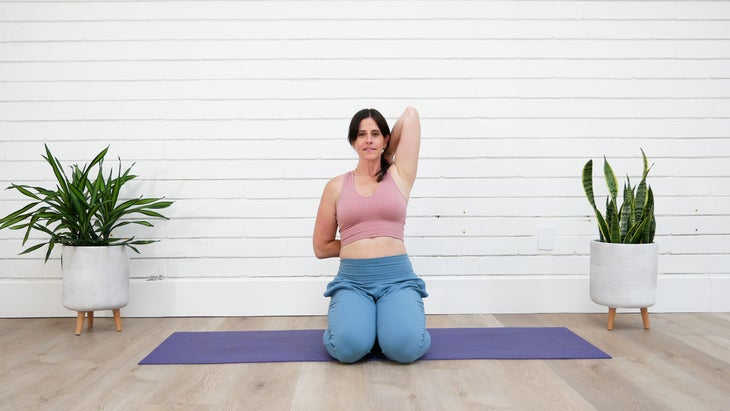
Virasana (Hero Pose) with Gomukhasana (Cow Face Pose) arms
If this is the only pose you can do today, do it! Not only does this posture open up the front thighs and shoulders, but it is the start of learning to find center amidst imbalances. In this case, one arm is overhead, and the other is behind the back. I used to be able to grab my wrist in this pose, but since a fairly debilitating shoulder injury, I now gladly use a strap. I have even used my ponytail when there were no props!
Place a block on the medium height between your ankles and come to sit, with your inner knees touching and big toes together. Inhale your right arm up in line with your ear, holding a strap if you are unable to clasp your hands. Bend your elbow, hugging your outer upper arm in toward your head. Reach your left arm out to the side. Internally rotate your left arm to position it as far up your back as you can comfortably. Hold the strap with both of your hands or clasp your fingers. Remain upright and take 10 deep breaths. Release your bottom arm first, then your top arm, and switch.
Adho Mukha Svanasana (Downward-Facing Dog) variation
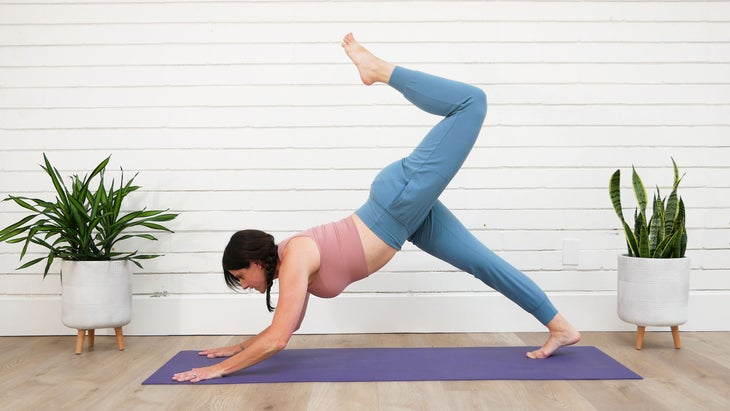
Let’s continue to work these asymmetrical shapes in different orientations. In Downward-Facing Dog, we are on our hands and in an inversion. Bending the elbows starts to open up the upper back, while bending the lifted leg, is a fun way to start lengthening the hip flexor. There is also a balancing aspect to this shape.
From Downward-Facing Dog, inhale your right leg up to the sky. Keep your hips level, so your right toes are pointing downward. Bend your elbows, wrapping your outer upper arms toward the back of your space and hover your forearms an inch from the ground. Maintain this posture as you bend your lifted leg, pulling your heel toward your bum. Melt your lower ribs toward the floor as you reach your chest and gaze between your thumbs. Take five breaths. Slowly straighten your arms at the elbows and your lifted leg and lower it before repeating on your second side.
Natarajasana (Lord of the Dance Pose) variation
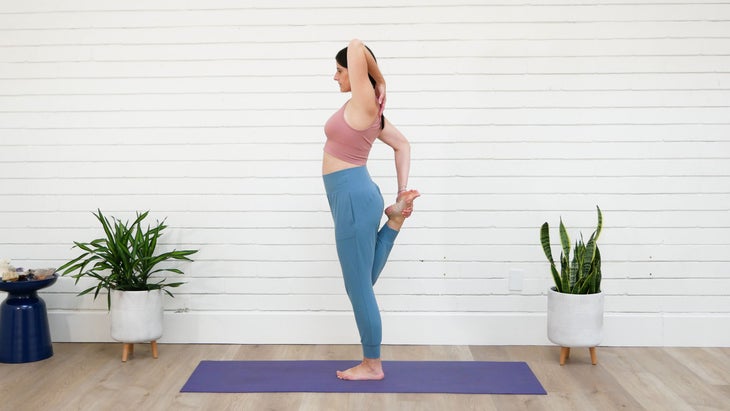
One of the mythical explanations of this posture, is that it is named for Shiva, the God of destruction. Shiva is the ultimate representation of embracing duality. His consort Shakti is often depicted in statues not as a separate being, but as his opposite side—reminding us of the yin and yang nature inside us all.
Standing at the top of your mat. Use your right hand to pull your right heel toward your bum. Lengthen through sit bones as you draw your right thigh back in line with your left. Bring your left arm up, in line with your ear, and bend your elbow like a mild Gomukhasana, with your palm lightly resting on your left shoulder. Eyes are steady either on the floor or directly ahead. Balance here for five full breaths. Release your top arm first, then lower your lifted leg. Pause in Tadasana before repeating on your left.
Humble Warrior variation
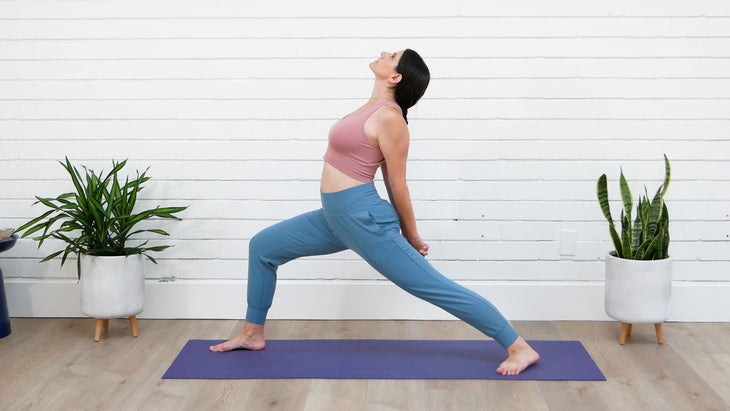
I love this pose, because it is real-life training in how to go against the forces that may be pulling us down. A huge component of Gherandasana is the ability to lift off the floor. Humble Warrior teaches us how to remain steadfast in our commitment to opening the heart, even when things may feel overwhelming or as though they are pulling us down.
Come into Warrior I from Downward-Facing Dog. Keeping your torso upright, interlace your hands behind your back or use a strap. Press into your front heel and back outer foot as you draw your front hip back and back hip forward. Begin to backbend in your upper spine, as if you could take your knuckles to your tailbone. Draw your navel in as you lift your chest toward your head. If your neck is healthy, look up. Remain for five breaths. Come out on an inhale, grounding into your feet and lifting your torso upright. Release your clasp and bring both hands to the floor. Step back to Downward-Facing Dog and repeat on your left.
Bhujangasana (Cobra Pose) variation
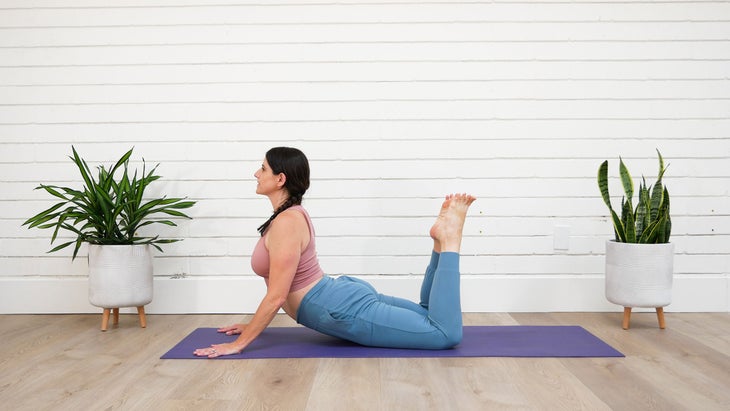
There are many different ways to backbend the body, but tummy backbends, where we lift away from the floor and therefore against gravity, are the most strengthening for the posterior side of the body. Physical therapists often use this family of poses to strengthen the hamstrings and back extensors.
Come onto your tummy. Bend your elbows and place your wrists under your shoulders. On an inhale, coil your spine lifting into Cobra Pose. Start to bend your knees as if you could kick your heels to your head. Pause on your exhales to lengthen through your low back. Over time you may start pressing your arms a little straighter, though your elbows should stay somewhat bent. Imagine that you are moving your head toward your feet, like you could rest them there like a little pillow. Your ankles are touching, though your inner thighs are hip-width to maintain space in your lower back. Breathe for five counts. Come out by first straightening your legs, and then lengthen your spine to lower back to the floor. Repeat one more time.
Anjaneyasana (Low Lunge) variation
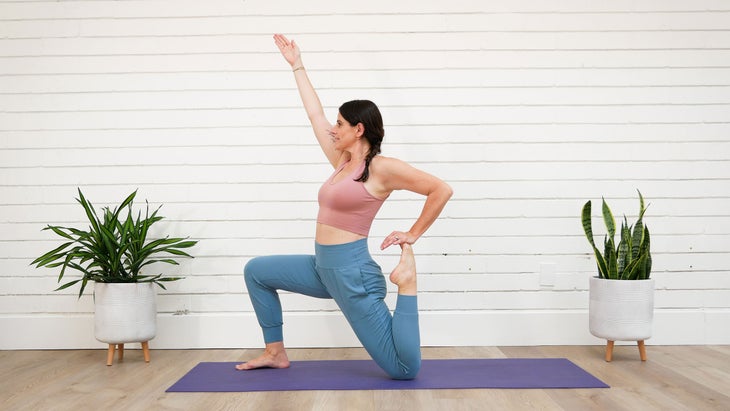
I liken the ability to do this next shoulder and hand position to being able to curl your tongue. It is likely more genetic than structural, so while it is always fun to try, if it does not happen, don’t worry about it. Remember the practice is in the journey.
We recommend having a blanket on your mat if you have sensitive knees. Start in a Low Lunge with your right foot forward. Walk your hands up your front leg. Bend your left knee and pull your heel toward your bum, holding your outer ankle. You may stay here if your front thighs feel restricted or you need to protect your shoulder. If your shoulder is healthy, place your left hand on the top of your foot and as if you were turning a doorknob, draw your upper arm and elbow toward the back of the room, so your arm is in Bhekasana. Either use your right arm for balance on your top thigh or lift your opposite arm in line with your ear on an inhale. Remain in your full expression of the pose for five breaths before releasing your back leg, lowering your arms, and switching to your left side.
Dhanurasana (Bow Pose)
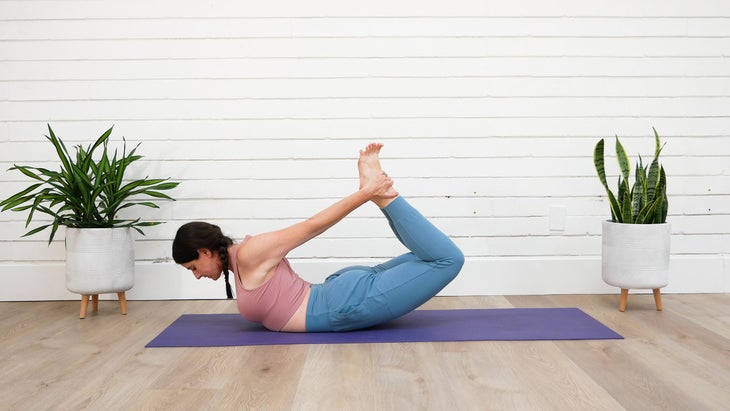
Before we play with our final shape, let’s take a moment of symmetry to re-center ourselves. Observe how this familiar and somewhat simpler shape feels after all the previous work you’ve done. A key element to our final shape is the strong lift of the Dhanurasana leg, so we will play with lifting the legs a little higher than the chest.
Lie on your belly and bend your knees. Hold your shin, ankle, or foot and pull your heels toward your bum. Press your shins back and on an inhale, lift your thighs off the floor. On an inhale, rock your weight toward your upper body so you are on your tummy and lower ribs. This will allow you to lift your legs even higher. Make them the highest point of the posture. Lengthen your tailbone toward your knees as you strongly lift your inner thighs skyward. Press your ankles (or feet) into your hands and use your shins pressing back to lift your chest higher. Maintain a long neck by gazing straight down. Stay lifted for five breaths. Lower slowly, releasing the grip of the legs and stretching your body out to straight before repeating one to two more times.
Gherandasana (Pose Dedicated to the Sage Gheranda)
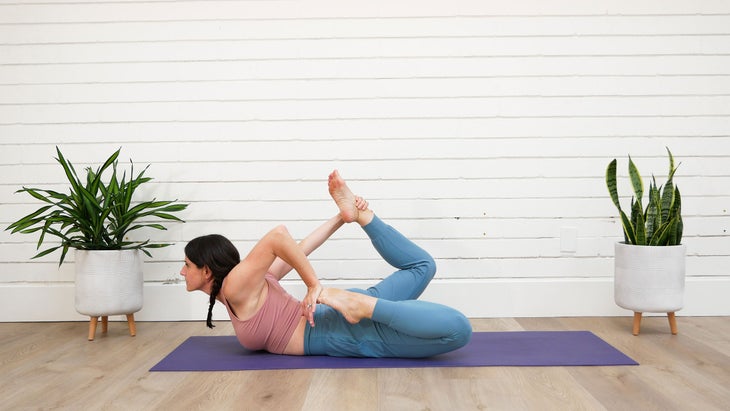
Here we go! Remember that the deeper work here is not to perform the posture perfectly, but instead learning how to find a sense of center when you are feeling pulled in multiple directions. Whether you get off the ground or not is irrelevant. Simply stay committed to the work of opening the heart and remaining connected to yourself and your breath.
Lying on your tummy, bend your right knee and place your hand onto the top of your foot, with your elbow pointing toward your midline. Turn your hand on the top of the foot so you are in Eka Pada Bhekasana (Frog Pose). Now, bend your left knee and grab your outer ankle. As you press your right hand down, inhale and lift your left leg up. This will also lift your chest. Breathe! Take a moment between every breath to get centered and then recommit to the work of each side. Lengthen the back of your neck by looking straight ahead or down. Hold for five breaths. On an exhale, release the legs and stretch your body out on the floor before repeating on the left. Feel free to try this more than once!
Watch this pose progression to Gherandasana
Sarah Ezrin demonstrates the step-by-step practice to help find balance in this posture.
See also:
6 Poses That Balance Challenge and Accessibility
